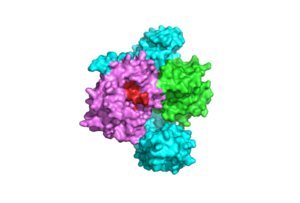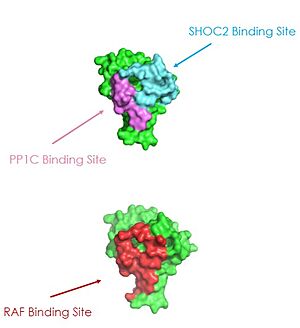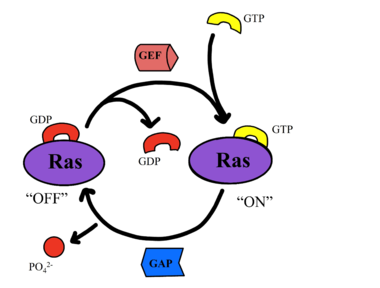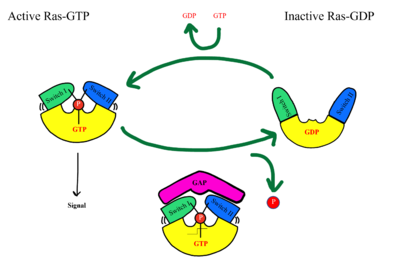Sandbox Reserved 1767
From Proteopedia
(Difference between revisions)
| (6 intermediate revisions not shown.) | |||
| Line 14: | Line 14: | ||
[[Image:MECH.png|700 px|center|thumb|'''Figure 1''': Mechanism of SMP complex formation and activation of RAF.<ref name="Liau">PMID: 35768504</ref><ref name="Lavoie">PMID: 35970881</ref>]] | [[Image:MECH.png|700 px|center|thumb|'''Figure 1''': Mechanism of SMP complex formation and activation of RAF.<ref name="Liau">PMID: 35768504</ref><ref name="Lavoie">PMID: 35970881</ref>]] | ||
The RAS-RAF signaling cascade is inhibited when RAF is phosphorylated at Ser259.<ref name="Kwon">PMID: 35831509</ref> There is a <scene name='95/952695/14-3-3/1'>14-3-3</scene> dimer present in the cytoplasm that interacts with RAF through [https://www.ncbi.nlm.nih.gov/pmc/articles/PMC4005716/. hydrogen bonds] between R129 of 14-3-3 and Ser259 of RAF when Ser259 is phosphorylated. This interaction causes an <scene name='95/952695/Autoinhibited_confirmation/9'>autoinhibited confirmation</scene> as 14-3-3 restricts RAF to the cytoplasm and sterically inhibits RAF from binding with RAS. This interaction is crucial in regulating [https://us.progen.com//Antibodies/Research-Area/Cell-Cycle-Proliferation/ cell proliferation], as it prevents cell growth in the absence of a signal. [https://www.ncbi.nlm.nih.gov/books/NBK26877/#:~:text=Extracellular%20Growth%20Factors%20Stimulate%20Cell,Cell%20Growth%2C%20Cell%20Division%2C%20and Extracellular Growth Factors] cause GTP to bind to MRAS which triggers SMP formation <ref name="Lavoie">PMID: 35970881</ref>.Upon SMP complex formation, PP1C is brought into close proximity of RAS, leading to the dephosphorylation of Ser259 of RAF by the active site of PP1C <ref name="Lavoie">PMID: 35970881</ref>. Once dephosphorylated, RAF is in the | The RAS-RAF signaling cascade is inhibited when RAF is phosphorylated at Ser259.<ref name="Kwon">PMID: 35831509</ref> There is a <scene name='95/952695/14-3-3/1'>14-3-3</scene> dimer present in the cytoplasm that interacts with RAF through [https://www.ncbi.nlm.nih.gov/pmc/articles/PMC4005716/. hydrogen bonds] between R129 of 14-3-3 and Ser259 of RAF when Ser259 is phosphorylated. This interaction causes an <scene name='95/952695/Autoinhibited_confirmation/9'>autoinhibited confirmation</scene> as 14-3-3 restricts RAF to the cytoplasm and sterically inhibits RAF from binding with RAS. This interaction is crucial in regulating [https://us.progen.com//Antibodies/Research-Area/Cell-Cycle-Proliferation/ cell proliferation], as it prevents cell growth in the absence of a signal. [https://www.ncbi.nlm.nih.gov/books/NBK26877/#:~:text=Extracellular%20Growth%20Factors%20Stimulate%20Cell,Cell%20Growth%2C%20Cell%20Division%2C%20and Extracellular Growth Factors] cause GTP to bind to MRAS which triggers SMP formation <ref name="Lavoie">PMID: 35970881</ref>.Upon SMP complex formation, PP1C is brought into close proximity of RAS, leading to the dephosphorylation of Ser259 of RAF by the active site of PP1C <ref name="Lavoie">PMID: 35970881</ref>. Once dephosphorylated, RAF is in the | ||
| - | <scene name='95/952695/Non-inhibited_confirmation/ | + | <scene name='95/952695/Non-inhibited_confirmation/11'>active confirmation</scene>, allowing RAS to bind RAF, initiating the signaling cascade.<ref name="Young">PMID: 30348783</ref> |
== Structure of Subunits == | == Structure of Subunits == | ||
| Line 33: | Line 33: | ||
==RAS== | ==RAS== | ||
| - | RAS proteins are GTP-dependent [https://pubmed.ncbi.nlm.nih.gov/14604583/. intracellular switches] that are anchored to the plasma membrane. <ref name="Liau">PMID: 35768504</ref> RAS proteins activate RAF kinases through direct binding and membrane recruitment, resulting in RAF dimerization and pathway activation <ref name="Liau">PMID: 35768504</ref>. The SMP complex has specificity for MRAS. Other RAS proteins may bind to SHOC2, but MRAS induces the complex formation with a significantly lower [https://www.ncbi.nlm.nih.gov/pmc/articles/PMC6004624/. dissociation constant] <ref name="Liau">PMID: 35768504</ref>. There are no known membrane interacting regions on SHOC2 and PP1C, meaning the [https://bio.libretexts.org/Bookshelves/Introductory_and_General_Biology/Book%3A_General_Biology_(Boundless)/03%3A_Biological_Macromolecules/3.05%3A_Lipid_Molecules_-_Phospholipids#:~:text=The%20fatty%20acid%20chains%20are,the%20intracellular%20and%20extracellular%20fluid. hydrophobic fatty acid tail] on MRAS is responsible for recruiting the complex to the cell membrane | + | RAS proteins are GTP-dependent [https://pubmed.ncbi.nlm.nih.gov/14604583/. intracellular switches] that are anchored to the plasma membrane. <ref name="Liau">PMID: 35768504</ref> RAS proteins activate RAF kinases through direct binding and membrane recruitment, resulting in RAF dimerization and pathway activation <ref name="Liau">PMID: 35768504</ref>. The SMP complex has specificity for MRAS. Other RAS proteins may bind to SHOC2, but MRAS induces the complex formation with a significantly lower [https://www.ncbi.nlm.nih.gov/pmc/articles/PMC6004624/. dissociation constant] <ref name="Liau">PMID: 35768504</ref>. There are no known membrane interacting regions on SHOC2 and PP1C, meaning the [https://bio.libretexts.org/Bookshelves/Introductory_and_General_Biology/Book%3A_General_Biology_(Boundless)/03%3A_Biological_Macromolecules/3.05%3A_Lipid_Molecules_-_Phospholipids#:~:text=The%20fatty%20acid%20chains%20are,the%20intracellular%20and%20extracellular%20fluid. hydrophobic fatty acid tail] on MRAS is responsible for recruiting the complex to the cell membrane. This allows only for 2D movement and increasing local concentrations of the players needed in this signaling pathway <ref name="Hauseman">PMID:35830882</ref>. |
A significant amount of steric overlap is seen in MRAS for the binding sites of PP1C, SHOC2, and RAF <ref name="Liau">PMID: 35768504</ref>. In '''Figure 3''', {{Font color|lime|MRAS}} is shown in green, with the {{Font color|cyan|SHOC2 binding site}} colored cyan, the {{Font color|violet|PP1C binding site}} colored violet, and the {{Font color|red|RAF binding site}} shown in red on a different RAS protein. Hence, multiple RAS proteins are required for further activation of the receptor tyrosine kinase pathway <ref name="Lavoie">PMID: 35970881</ref>. Due to the significant overlap in binding domains, one MRAS molecule is needed to recruit SHOC2 and PP1C to the membrane, and another RAS molecule is needed activate RAF <ref name="Lavoie">PMID: 35970881</ref>. The ability of MRAS-GTP to cluster at the cell membrane is a crucial capability for this protein complex. The presence of this <scene name='95/952695/413cellmemprotrusion/4'>palmitoylated tail</scene> is responsible for this anchoring to the cell membrane, similar to the hydrophobic fatty acid tail on MRAS that is responsible for recruiting SMP to the cell membrane. | A significant amount of steric overlap is seen in MRAS for the binding sites of PP1C, SHOC2, and RAF <ref name="Liau">PMID: 35768504</ref>. In '''Figure 3''', {{Font color|lime|MRAS}} is shown in green, with the {{Font color|cyan|SHOC2 binding site}} colored cyan, the {{Font color|violet|PP1C binding site}} colored violet, and the {{Font color|red|RAF binding site}} shown in red on a different RAS protein. Hence, multiple RAS proteins are required for further activation of the receptor tyrosine kinase pathway <ref name="Lavoie">PMID: 35970881</ref>. Due to the significant overlap in binding domains, one MRAS molecule is needed to recruit SHOC2 and PP1C to the membrane, and another RAS molecule is needed activate RAF <ref name="Lavoie">PMID: 35970881</ref>. The ability of MRAS-GTP to cluster at the cell membrane is a crucial capability for this protein complex. The presence of this <scene name='95/952695/413cellmemprotrusion/4'>palmitoylated tail</scene> is responsible for this anchoring to the cell membrane, similar to the hydrophobic fatty acid tail on MRAS that is responsible for recruiting SMP to the cell membrane. | ||
| - | MRAS contains two regions called Switch I (SWI) and Switch II (SWII) that undergo conformational changes depending if MRAS is bound to GDP or GTP <ref name="Liau">PMID: 35768504</ref>. The conformation of these switches determines if the SMP complex can form or not. Mutations to MRAS can lead to consistent GTP-loading, causing an increase in the formation of the SMP complex | + | MRAS contains two regions called Switch I (SWI) and Switch II (SWII) that undergo conformational changes depending if MRAS is bound to GDP or GTP <ref name="Liau">PMID: 35768504</ref>. The conformation of these switches determines if the SMP complex can form or not. Mutations to MRAS can lead to consistent GTP-loading, causing an increase in the formation of the SMP complex as well as consistent activation of the cell-proliferation pathway in the absence of external growth factors. |
| Line 48: | Line 48: | ||
=== Cancer and Rasopathies === | === Cancer and Rasopathies === | ||
| - | Common mutations in SHOC2 and PP1C lead to amino acid changes on the interaction surfaces, | + | Common mutations in SHOC2 and PP1C lead to amino acid changes on the interaction surfaces, which can result in [https://www.ncbi.nlm.nih.gov/pmc/articles/PMC2692211/. higher binding affinity].<ref name="Lavoie">PMID: 35970881</ref>The interface of SHOC2-PP1C is stabilized by the <scene name='95/952695/Q249k_mutation/1'>Q249K</scene> mutation because this creates a salt bridge with E116 of PP1C. This enhances the binding energy by -22.7 kcal/mol. Mutations to MRAS can result in consistent GTP-loading, increasing the formation of the SMP complex in the absence of external growth factors that are necessary for activation of the pathway in a healthy organism. The majority of wild type MRAS in cells are bound to GDP, whereas the MRAS with the Q71L mutation locked MRAS in the GTP bound state.<ref name="Hauseman">PMID:35830882</ref> In MRAS, <scene name='95/952695/Q249k_mutation/2'>Q71L and G23V</scene> both show increased interaction with other effectors such as BRAF, CRAF, and AF6, consistent with gain-of-function mutations that activate MRAS, leading to GTP-loading. |
| - | Mutations in PP1C can trigger increased active site activity, increasing the RAF proteins that are active and available to bind to RAS. In patients with [https://medlineplus.gov/genetics/condition/noonan-syndrome/#:~:text=Noonan%20syndrome%20is%20a%20condition,many%20other%20signs%20and%20symptoms. Noonan Syndrome], a disease in the RASopathy family, a point mutation of <scene name='95/952695/Q249k_mutation/2'>T68I</scene> MRAS was identified, however | + | Mutations in PP1C can trigger increased active site activity, increasing the RAF proteins that are active and available to bind to RAS. In patients with [https://medlineplus.gov/genetics/condition/noonan-syndrome/#:~:text=Noonan%20syndrome%20is%20a%20condition,many%20other%20signs%20and%20symptoms. Noonan Syndrome], a disease in the RASopathy family, a point mutation of <scene name='95/952695/Q249k_mutation/2'>T68I</scene> MRAS was identified, however the effects this has are unknown.<ref name="Young">PMID: 30348783</ref> Universally, when this MAPK cascade is unregulated, cells are able to proliferate regardless of external signals, leading to [https://www.ncbi.nlm.nih.gov/books/NBK20362/. cancer] and/or RASopathies. |
Current revision
| This Sandbox is Reserved from February 27 through August 31, 2023 for use in the course CH462 Biochemistry II taught by R. Jeremy Johnson at the Butler University, Indianapolis, USA. This reservation includes Sandbox Reserved 1765 through Sandbox Reserved 1795. |
To get started:
More help: Help:Editing |
SHOC2-PP1C-MRAS
| |||||||||||
References
- ↑ 1.0 1.1 1.2 1.3 1.4 1.5 1.6 Kwon JJ, Hajian B, Bian Y, Young LC, Amor AJ, Fuller JR, Fraley CV, Sykes AM, So J, Pan J, Baker L, Lee SJ, Wheeler DB, Mayhew DL, Persky NS, Yang X, Root DE, Barsotti AM, Stamford AW, Perry CK, Burgin A, McCormick F, Lemke CT, Hahn WC, Aguirre AJ. Structure-function analysis of the SHOC2-MRAS-PP1C holophosphatase complex. Nature. 2022 Jul 13. pii: 10.1038/s41586-022-04928-2. doi:, 10.1038/s41586-022-04928-2. PMID:35831509 doi:http://dx.doi.org/10.1038/s41586-022-04928-2
- ↑ 2.00 2.01 2.02 2.03 2.04 2.05 2.06 2.07 2.08 2.09 2.10 Hauseman ZJ, Fodor M, Dhembi A, Viscomi J, Egli D, Bleu M, Katz S, Park E, Jang DM, Porter KA, Meili F, Guo H, Kerr G, Molle S, Velez-Vega C, Beyer KS, Galli GG, Maira SM, Stams T, Clark K, Eck MJ, Tordella L, Thoma CR, King DA. Structure of the MRAS-SHOC2-PP1C phosphatase complex. Nature. 2022 Jul 13. pii: 10.1038/s41586-022-05086-1. doi:, 10.1038/s41586-022-05086-1. PMID:35830882 doi:http://dx.doi.org/10.1038/s41586-022-05086-1
- ↑ 3.00 3.01 3.02 3.03 3.04 3.05 3.06 3.07 3.08 3.09 3.10 3.11 3.12 3.13 3.14 3.15 3.16 3.17 3.18 3.19 3.20 3.21 3.22 3.23 Liau NPD, Johnson MC, Izadi S, Gerosa L, Hammel M, Bruning JM, Wendorff TJ, Phung W, Hymowitz SG, Sudhamsu J. Structural basis for SHOC2 modulation of RAS signalling. Nature. 2022 Jun 29. pii: 10.1038/s41586-022-04838-3. doi:, 10.1038/s41586-022-04838-3. PMID:35768504 doi:http://dx.doi.org/10.1038/s41586-022-04838-3
- ↑ 4.0 4.1 4.2 4.3 4.4 4.5 4.6 4.7 Lavoie H, Therrien M. Structural keys unlock RAS-MAPK cellular signalling pathway. Nature. 2022 Sep;609(7926):248-249. PMID:35970881 doi:10.1038/d41586-022-02189-7
- ↑ 5.0 5.1 Young LC, Hartig N, Boned Del Río I, Sari S, Ringham-Terry B, Wainwright JR, Jones GG, McCormick F, Rodriguez-Viciana P. SHOC2-MRAS-PP1 complex positively regulates RAF activity and contributes to Noonan syndrome pathogenesis. Proc Natl Acad Sci U S A. 2018 Nov 6;115(45):E10576-E10585. PMID:30348783 doi:10.1073/pnas.1720352115
- ↑ Kelker MS, Page R, Peti W. Crystal structures of protein phosphatase-1 bound to nodularin-R and tautomycin: a novel scaffold for structure-based drug design of serine/threonine phosphatase inhibitors. J Mol Biol. 2009 Jan 9;385(1):11-21. Epub 2008 Nov 1. PMID:18992256 doi:10.1016/j.jmb.2008.10.053
Student Contributors
- Sloan August
- Rosa Trippel
- Kayla Wilhoite





